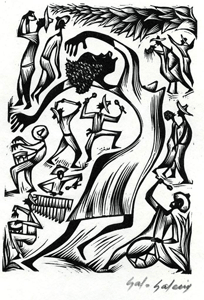A portfolio of 31 compelling prints by one of the foremost Ecuadorian artists of the 20th century, titled Galo Galecio: Bajo la Linea del Ecuador (Below the Equatorial Line).
Created by Galecio (1908-1993) in 1946 and accessioned in the FAC Permanent Collection in 1953, these important works have not been on exhibition since and have never been displayed at the FAC. Considered Galecio’s best work, these prints, made from engraved printing plates, depict scenes of village life from the tropical landscape of the coastal towns of Ecuador.
“The tropical landscape is used as a backdrop to make strong political and social statements about the condition of the working people of this South American country,” said FAC Curator Tariana Navas-Nieves, who organized the exhibit.
The FAC is in the midst of moving its vast – 23,600 piece – permanent collection from storage facilities in Denver to new on-site storage vaults. Navas-Nieves discovered this historically significant collection of prints, complete in its original portfolio, while studying the collection during the move.
“We have a tremendously rich collection of modern and contemporary works from throughout Latin America that, along with our Southwestern works, will undoubtedly distinguish the Fine Arts Center,” said Navas-Nieves. “This collection by Galo Galecio is one of many exciting discoveries we’ve made during the move.”
With the recent gallery expansion last year, FAC patrons have enjoyed the reemergence of the voluminous permanent collection. But while the collection is permanent, the exhibits on the first floor at the Fine Arts Center Main are not. This exhibition, displayed in the Marguerite and Otto Manley Gallery for works on paper, is the first in a complete rotation of works in the first floor galleries patrons can expect throughout the year.
“In the coming year, we will continue to display significant modern and contemporary Latin American works from the collection to tell a more complete and inclusive story of the arts in Hispanic America,” said Navas-Nieves.
ABOUT THE ARTIST
Galecio, one of Ecuador’s most notable artists of the 20th century, was a painter, sculptor, caricaturist, and printmaker. After studying at the School of Fine Arts in Guayaquil, Ecuador’s largest city and main port, the artist received a scholarship to study printmaking and mural painting at the Academia Nacional de Bellas Artes (National Academy of Fine Arts) in Mexico from 1944-1946. While in Mexico, he studied with the famous muralist Diego Rivera, became a member of the Taller de Gráfica Popular, one of the most influential printmaking workshops in the world, and created his first print portfolio, Bajo la Linea del Ecuador.
ABOUT THE EXHIBITION
This series of prints is widely considered to be Galecio’s best and depicts scenes of village life and the tropical landscape of the coastal towns of Ecuador. Whether they are images of work, culture, family or death, Galecio creates deeply poignant life portraits full of sentiment and expressive force. He captures the strength, perseverance and spirit of the hardworking and suffering people of his Ecuadorian land, particularly the indigenous and black people. Through dramatic works of great composition and style, the artist makes statements about the political and social state of Ecuador drawing attention to people he believes have been forgotten. The force of these images makes Galecio one of the greatest exponents of the Expressionist and Realist movements that dominated the artistic scene in Ecuador from the 1930s through the 1950s. Galecio’s work is in numerous international collections including the Museum of Modern Art in New York.
ABOUT PRINTMAKING AND ENGRAVINGS
An original print is any work that is drawn, painted or engraved by an artist on various supports including stone, metal, wood, or linoleum, and that afterwards is inked and printed on paper using a press. For wood or linoleum engraving, like Galecio’s, a design is incised into the plate with a cutting tool. What makes this technique difficult is that the artist must remove from the plate everything that is not to be inked. Then an ink roller is run over the surface and it is applied on a piece of paper using a press.


